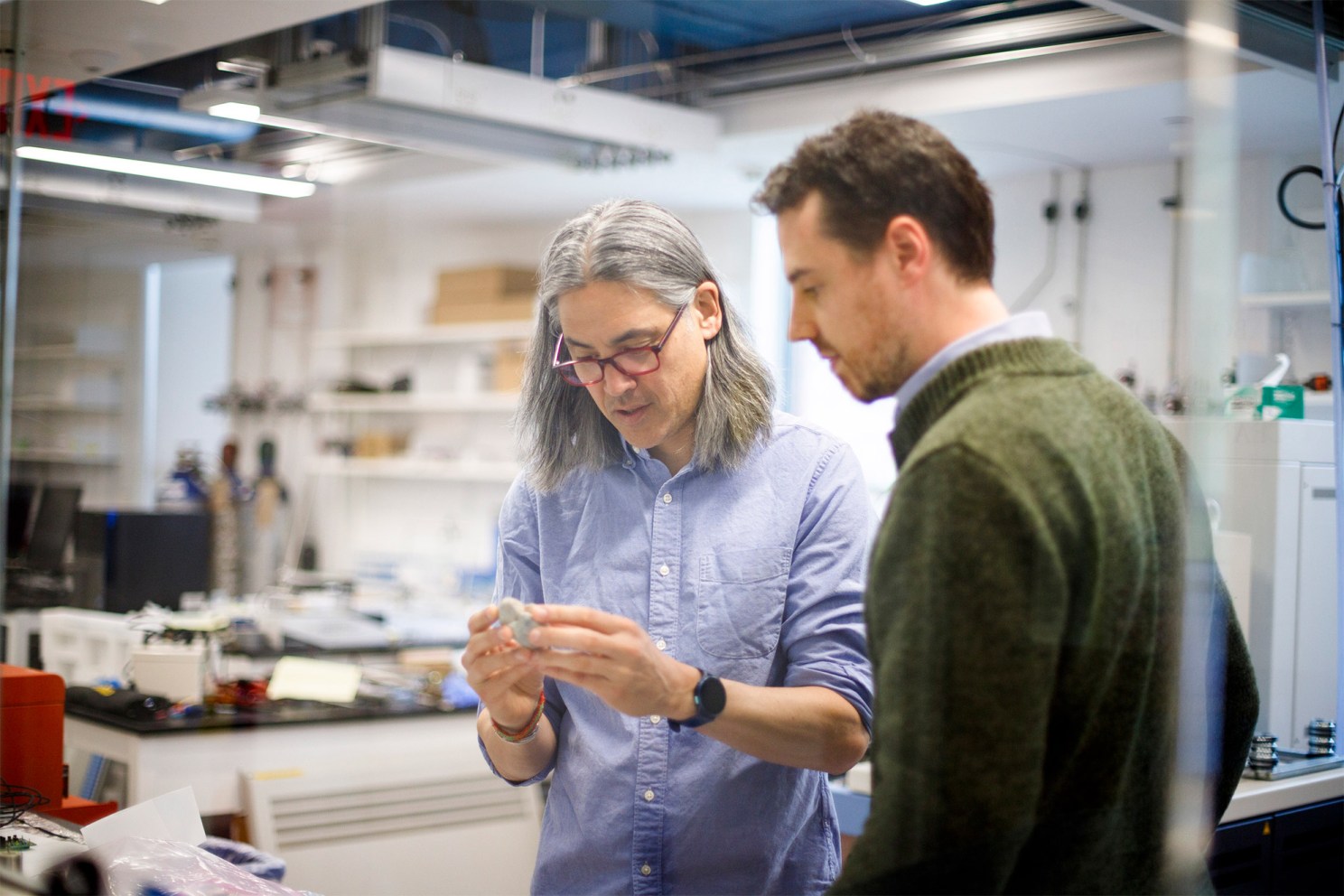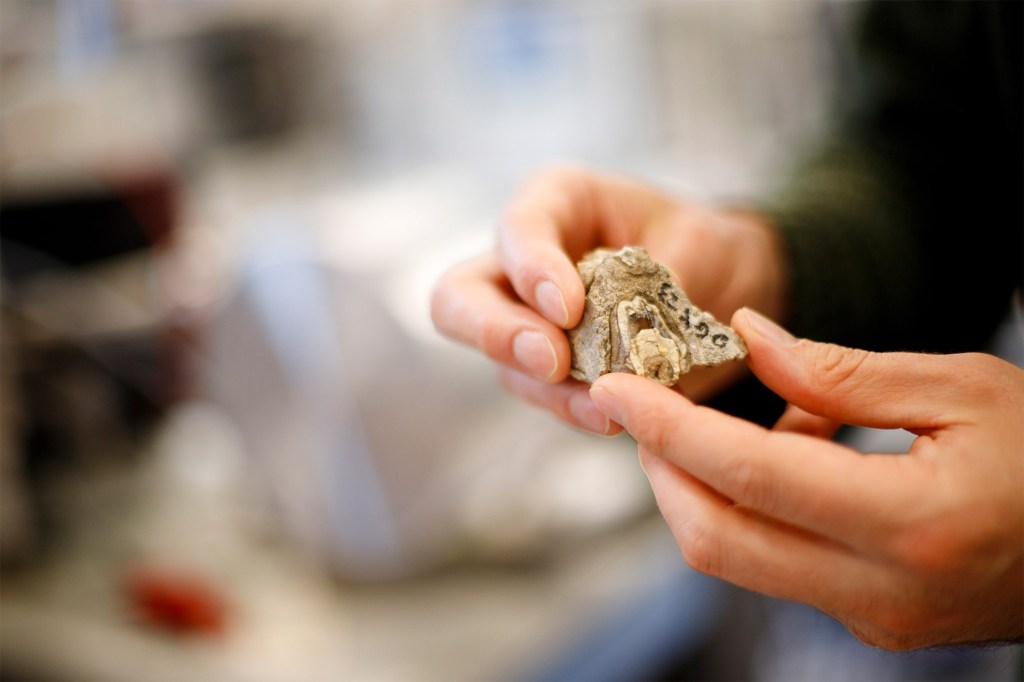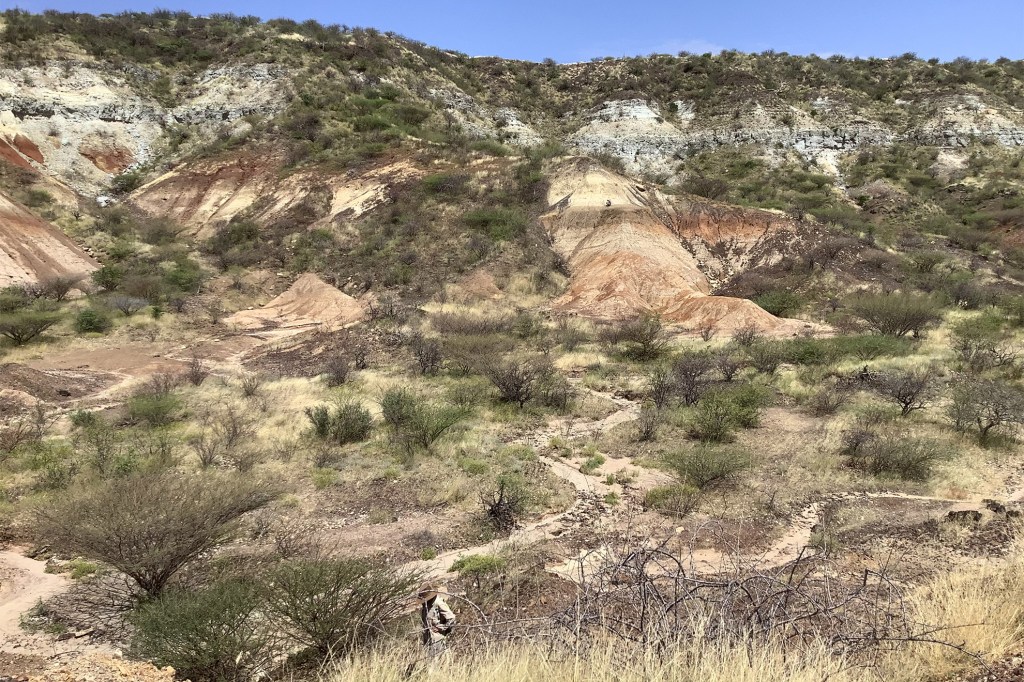Long in the tooth

Kevin Uno (left) and Daniel Green look at fossil samples in the lab.
Photo by Grace DuVal
Research finds 18-million-year-old enamel proteins in mammal fossils, offering window into how prehistoric animals lived, evolved
Proteins degrade over time, making their history hard to study. But new research has uncovered ancient proteins in the enamel of the teeth of 18-million-year-old fossilized mammals from Kenya’s Rift Valley, opening a window into how these animals lived and evolved.
In their new paper in Nature, researchers from Harvard and the Smithsonian Museum Conservation Institute discuss their findings.
“Teeth are rocks in our mouths,” explained Daniel Green, field program director in the Department of Human Evolutionary Biology and the paper’s lead author. “They’re the hardest structures that any animals make, so you can find a tooth that is a hundred or a hundred million years old, and it will contain a geochemical record of the life of the animal.”
That includes what the animal ate and drank, as well as its environment.

Green examining fossils from a northern Kenyan site called Napudet.
Photo by Fred Horne

A fossil sample.
Photo by Grace DuVal
“In the past, we thought that mature enamel, the hardest part of teeth, should really have very few proteins in it at all,” said Green. However, utilizing a newer proteomics technique called liquid chromatography tandem mass spectrometry, the team was able to detect “a great diversity of proteins … in different biological tissues.”
“The technique involves several stages where peptides are separated based on their size or chemistry so that they can be sequentially analyzed at higher resolutions than was possible with previous methods,” explained Kevin T. Uno, associate professor in HEB and one of the paper’s corresponding authors.
“We and other scholars recently found that there are dozens — if not even hundreds — of different kinds of proteins present inside tooth enamel,” said Green.
With the realization that many proteins are found in contemporary teeth, the researchers turned to fossils, collaborating with the Smithsonian and the National Museum of Kenya for access to fossilized teeth, particularly those of early elephants and rhinos.
As herbivores, they had large teeth to grind the plants that made up their diets. These mammals, Green said, “can have enamel two to three millimeters thick. It was a lot of material to work with.”
What they found — peptide fragments, chains of amino acids, that together form proteins as old as 18 million years — was “field-changing,” according to Green.
“Nobody’s ever found peptide fragments that are this old before,” he said, calling the findings “kind of shocking.”
Until now, the oldest prior findings were put at about 3.5 million years old, he said.
“With the help of our colleague Tim Cleland, a superb paleoproteomicist at the Smithsonian, we’re pushing back the age of peptide fragments by five or six times what was known before.”

Formed approximately 16 million years ago, the Buluk site in Kenya is found in one of the most remote and inhospitable places in the rift, but has yielded an extraordinary diversity of fossil fauna.
Photo by Ellen Miller
The newly discovered peptides cover a range of proteins that perform different functions, altogether known as the proteome, Green said.
“One of the reasons that we’re excited about these ancient teeth is that we don’t have the full proteome of all proteins that could have been found inside the bodies of these ancient elephants or rhinoceros, but we do have a group of them.”
With such a collection, “There might be more information available from a group of them than just one protein by itself.”
This research “opens new frontiers in paleobiology, allowing scientists to go beyond bones and morphology to reconstruct the molecular and physiological traits of extinct animals and hominins,” said Emmanuel K. Ndiema, senior research scientist at the National Museum of Kenya and paper co-author. “This provides direct evidence of evolutionary relationships. Combined with other characteristics of teeth, we can infer dietary adaptations, disease profiles, and even age at death — insights that were previously inaccessible.”
In addition to shedding light on the lives of these creatures, it helps place them in history.
“We can use these peptide fragments to explore the relationships between ancient animals, similar to how modern DNA in humans is used to identify how people are related to one another,” Uno said.
“Even if an animal is completely extinct — and we have some animals that we analyze in our study who have no living descendants — you can still, in theory, extract proteins from their teeth and try to place them on a phylogenetic tree,” said Green.
Such information “might be able to resolve longstanding debates between paleontologists about what other mammalian lineages these animals are related to using molecular evidence.”
Although this research began as “a small side project” of a much larger project involving dozens of institutions and researchers from around the world, said Green, “We were surprised at just how much we found. There really are a lot of proteins preserved in these teeth.”
This research was partially funded by the National Science Foundation and Smithsonian’s Museum Conservation Institute.





